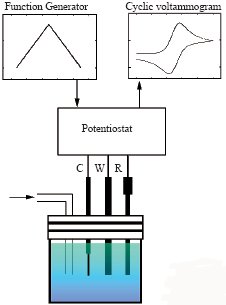
What is CV (Cyclic Voltammetry) Measurement?
Linear Sweep Voltammetry (LSV) measures the
electric response with sampling it at a constant scan rate from
initial to final electric potential.
Cyclic voltammetry (CV) is a reversible LSV
measurement which scans electric potential turned to reverse
direction after reaching final potential and scan back to initial
potential. In CV, the reversibility of the product produced in
forward scanning can be analyzed by backward scanning. Because of
this characteristic CV has been applied widely. If a CV conduct with
potential
wave form as shown in right then
we can study the substance characteristic as:
- Stability in oxidized and reduced forms.
- Molecular adsorption in redox process.
- Measurements of kinetic rate constants.
- Study of reaction mechanism.
- Reversibility of electrochemical reaction.
- Standard redox potential, Eo=(Epa+Epc)/2
- Electron transfer number, ΔE=Epa-Epc=
58/n,
*n: electron transfer number per mole
Working Electrode - More Information
- Potential Window [Pt, Hg, Carbon] in Aqueous Solution
- What is CV (Cyclic Voltammetry) Measurement?
- Working electrode selection
- Micro electrodes
- Variety, Features and Shapes of Working electrodes
- Full Listing of Working Electrodes and Accessories
-
David K.Gosser,Jr.,Cyclic Voltammetry Reaction
Mechanisms,VCH Publishers,Inc1994.